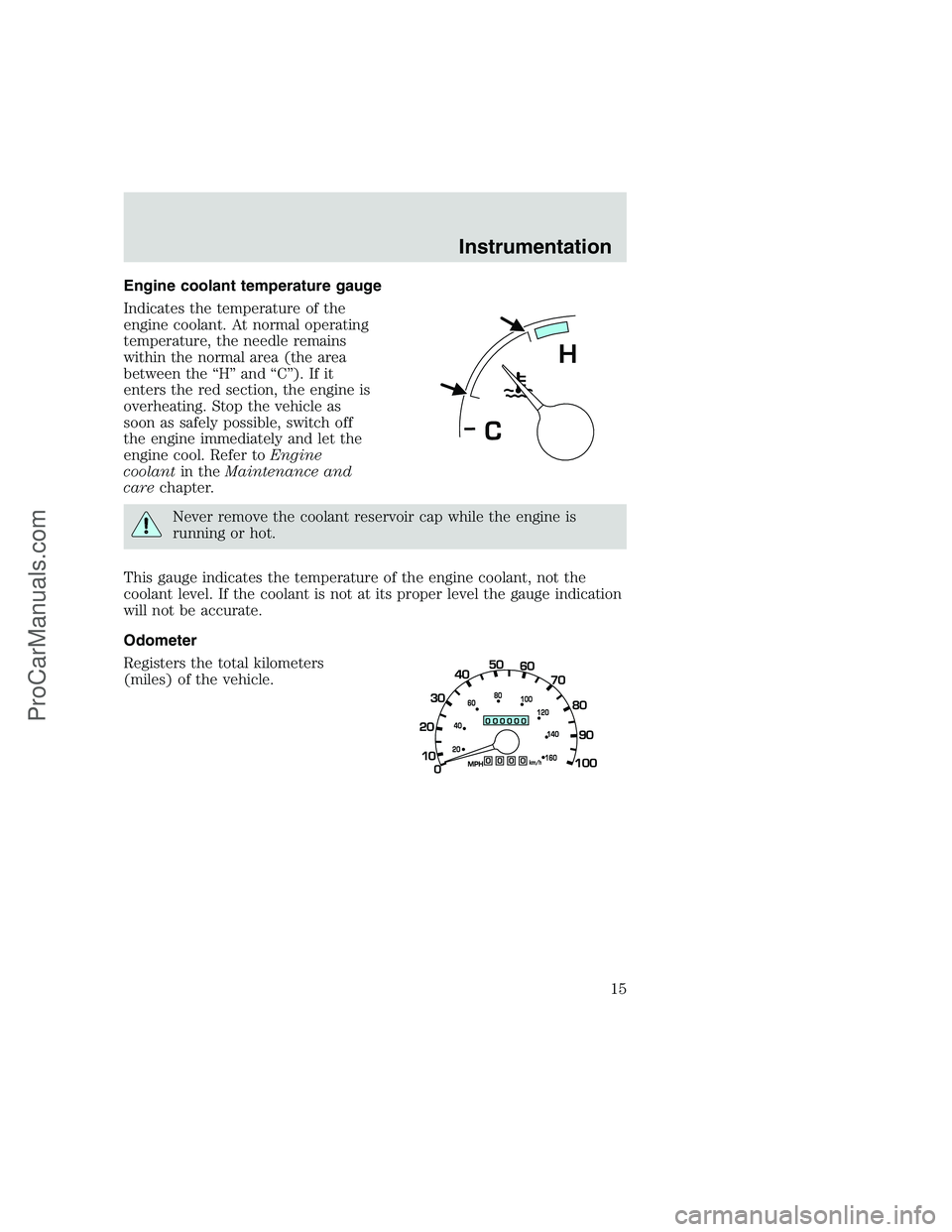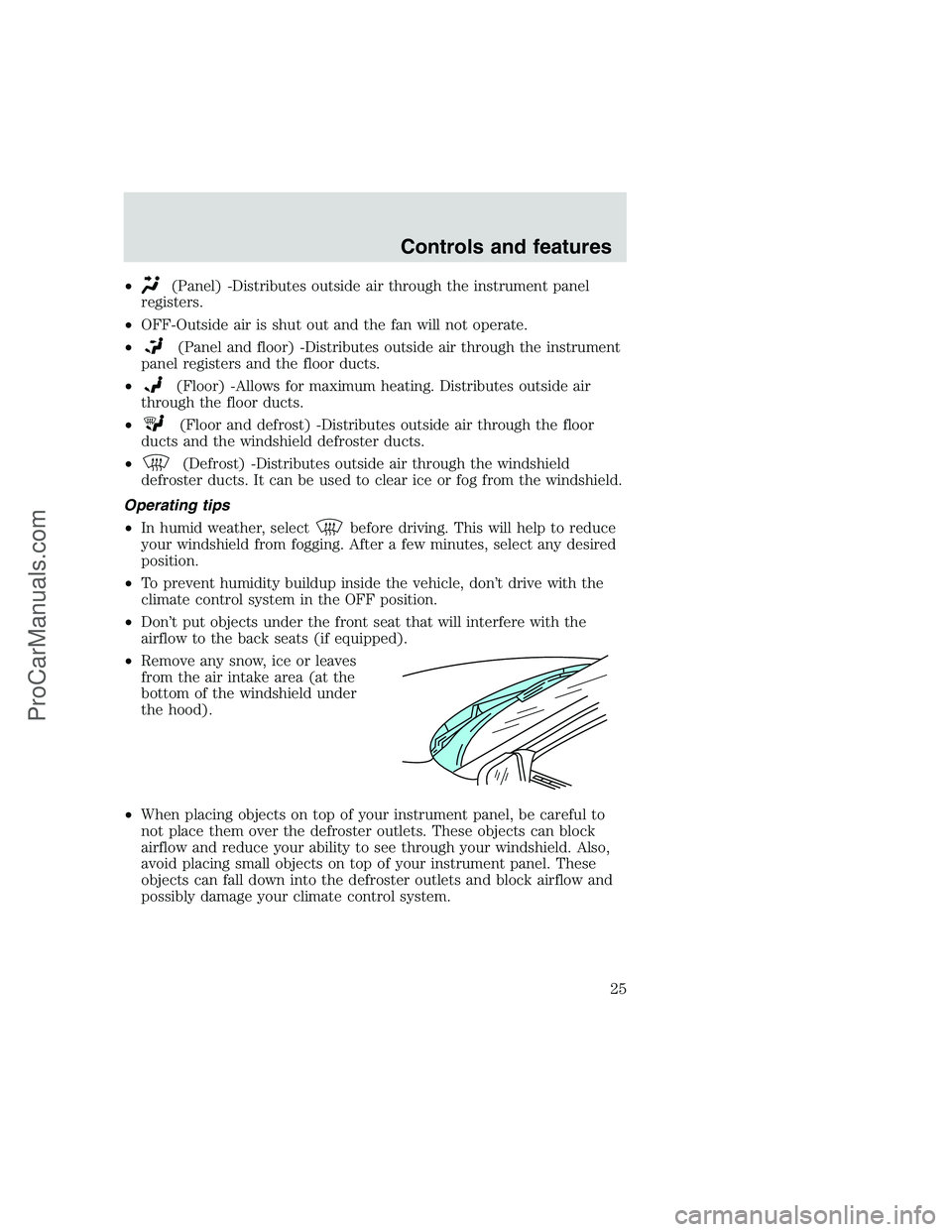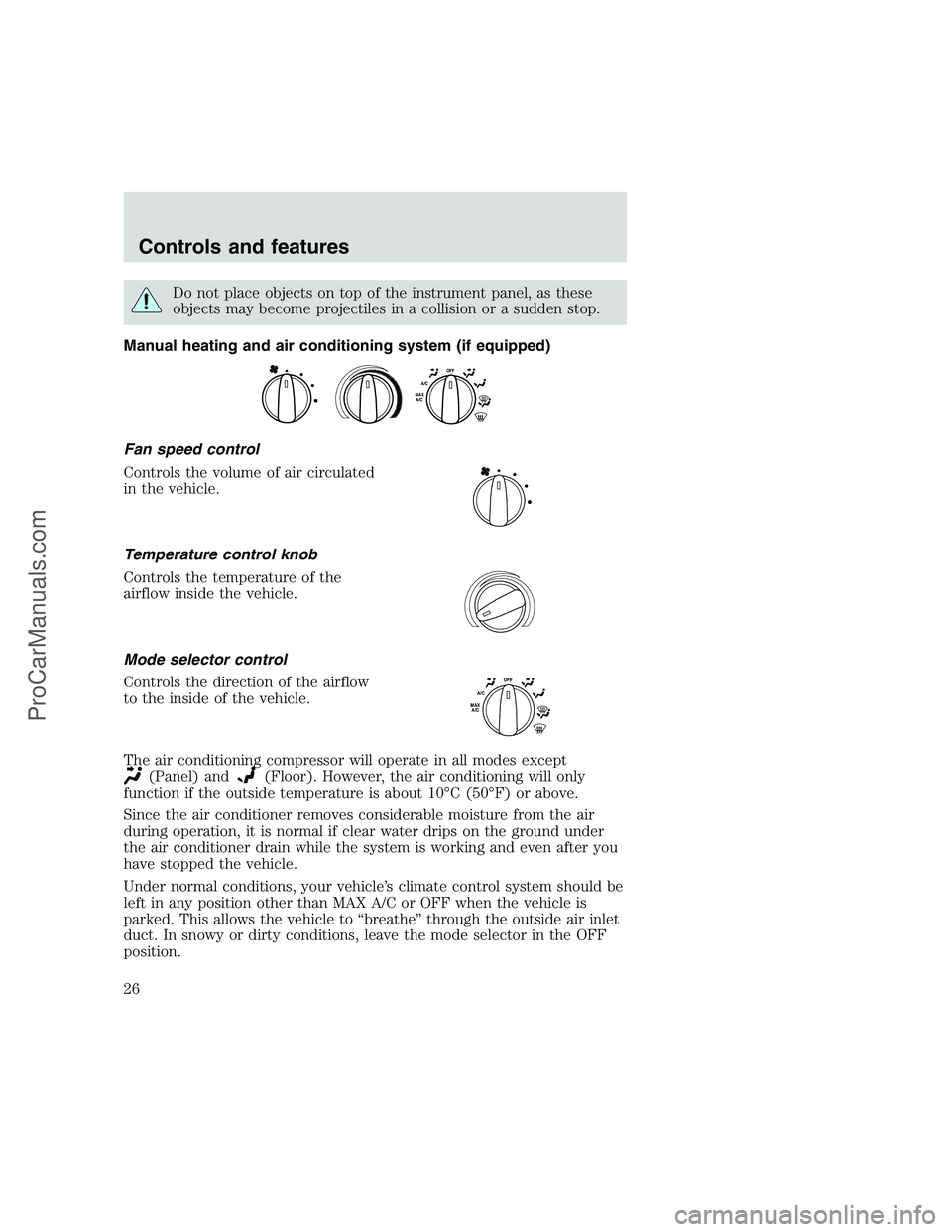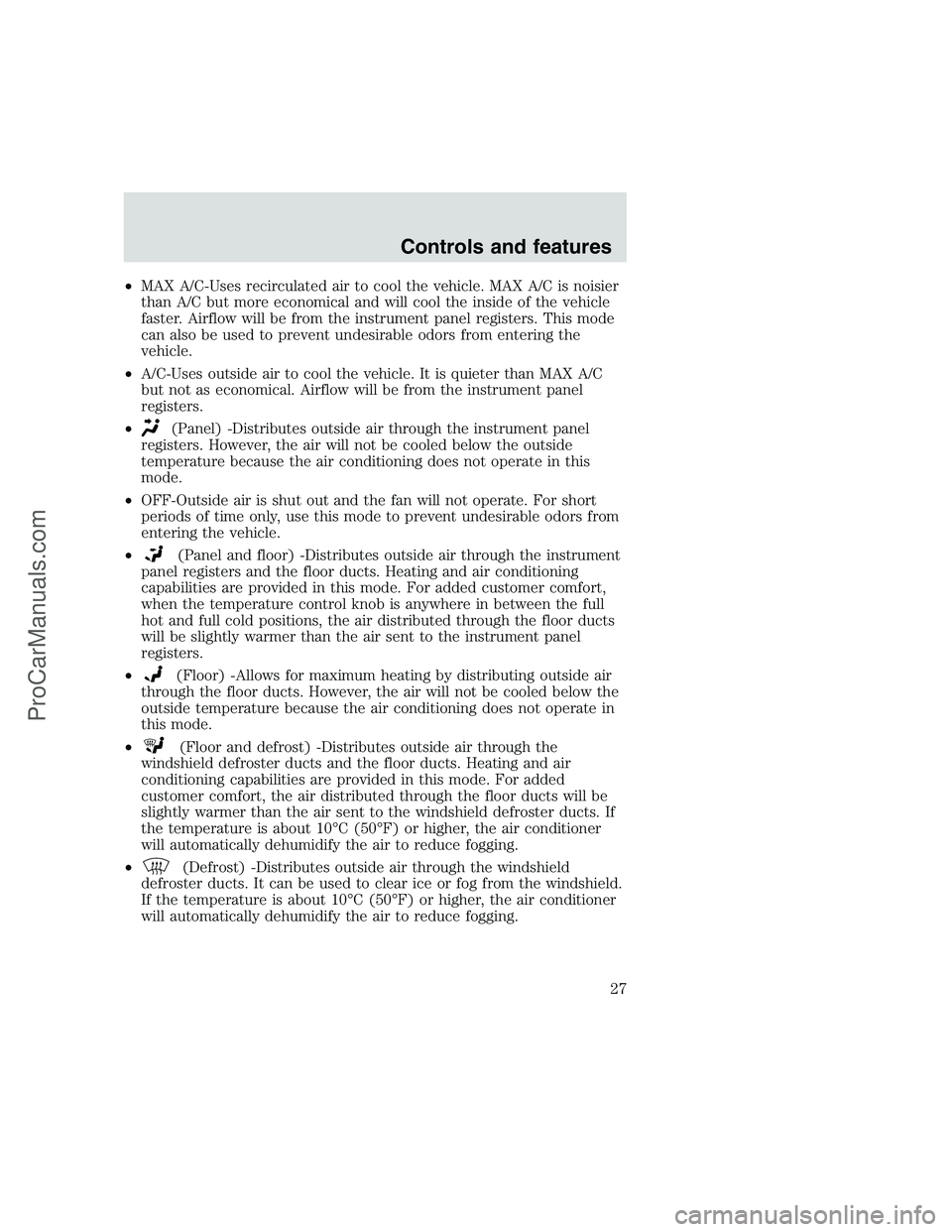1999 FORD F250 heating
[x] Cancel search: heatingPage 15 of 248

Engine coolant temperature gauge
Indicates the temperature of the
engine coolant. At normal operating
temperature, the needle remains
within the normal area (the area
between the “H” and “C”). If it
enters the red section, the engine is
overheating. Stop the vehicle as
soon as safely possible, switch off
the engine immediately and let the
engine cool. Refer toEngine
coolantin theMaintenance and
carechapter.
Never remove the coolant reservoir cap while the engine is
running or hot.
This gauge indicates the temperature of the engine coolant, not the
coolant level. If the coolant is not at its proper level the gauge indication
will not be accurate.
Odometer
Registers the total kilometers
(miles) of the vehicle.
H
C
Instrumentation
15
ProCarManuals.com
Page 25 of 248

•(Panel) -Distributes outside air through the instrument panel
registers.
•OFF-Outside air is shut out and the fan will not operate.
•
(Panel and floor) -Distributes outside air through the instrument
panel registers and the floor ducts.
•
(Floor) -Allows for maximum heating. Distributes outside air
through the floor ducts.
•
(Floor and defrost) -Distributes outside air through the floor
ducts and the windshield defroster ducts.
•
(Defrost) -Distributes outside air through the windshield
defroster ducts. It can be used to clear ice or fog from the windshield.
Operating tips
•In humid weather, select
before driving. This will help to reduce
your windshield from fogging. After a few minutes, select any desired
position.
•To prevent humidity buildup inside the vehicle, don’t drive with the
climate control system in the OFF position.
•Don’t put objects under the front seat that will interfere with the
airflow to the back seats (if equipped).
•Remove any snow, ice or leaves
from the air intake area (at the
bottom of the windshield under
the hood).
•When placing objects on top of your instrument panel, be careful to
not place them over the defroster outlets. These objects can block
airflow and reduce your ability to see through your windshield. Also,
avoid placing small objects on top of your instrument panel. These
objects can fall down into the defroster outlets and block airflow and
possibly damage your climate control system.
Controls and features
25
ProCarManuals.com
Page 26 of 248

Do not place objects on top of the instrument panel, as these
objects may become projectiles in a collision or a sudden stop.
Manual heating and air conditioning system (if equipped)
Fan speed control
Controls the volume of air circulated
in the vehicle.
Temperature control knob
Controls the temperature of the
airflow inside the vehicle.
Mode selector control
Controls the direction of the airflow
to the inside of the vehicle.
The air conditioning compressor will operate in all modes except
(Panel) and(Floor). However, the air conditioning will only
function if the outside temperature is about 10°C (50°F) or above.
Since the air conditioner removes considerable moisture from the air
during operation, it is normal if clear water drips on the ground under
the air conditioner drain while the system is working and even after you
have stopped the vehicle.
Under normal conditions, your vehicle’s climate control system should be
left in any position other than MAX A/C or OFF when the vehicle is
parked. This allows the vehicle to “breathe” through the outside air inlet
duct. In snowy or dirty conditions, leave the mode selector in the OFF
position.
O
F
FA/CM
A
X
A
/
C
O
F
FA/CM
A
X
A
/
C
Controls and features
26
ProCarManuals.com
Page 27 of 248

•MAX A/C-Uses recirculated air to cool the vehicle. MAX A/C is noisier
than A/C but more economical and will cool the inside of the vehicle
faster. Airflow will be from the instrument panel registers. This mode
can also be used to prevent undesirable odors from entering the
vehicle.
•A/C-Uses outside air to cool the vehicle. It is quieter than MAX A/C
but not as economical. Airflow will be from the instrument panel
registers.
•
(Panel) -Distributes outside air through the instrument panel
registers. However, the air will not be cooled below the outside
temperature because the air conditioning does not operate in this
mode.
•OFF-Outside air is shut out and the fan will not operate. For short
periods of time only, use this mode to prevent undesirable odors from
entering the vehicle.
•
(Panel and floor) -Distributes outside air through the instrument
panel registers and the floor ducts. Heating and air conditioning
capabilities are provided in this mode. For added customer comfort,
when the temperature control knob is anywhere in between the full
hot and full cold positions, the air distributed through the floor ducts
will be slightly warmer than the air sent to the instrument panel
registers.
•
(Floor) -Allows for maximum heating by distributing outside air
through the floor ducts. However, the air will not be cooled below the
outside temperature because the air conditioning does not operate in
this mode.
•
(Floor and defrost) -Distributes outside air through the
windshield defroster ducts and the floor ducts. Heating and air
conditioning capabilities are provided in this mode. For added
customer comfort, the air distributed through the floor ducts will be
slightly warmer than the air sent to the windshield defroster ducts. If
the temperature is about 10°C (50°F) or higher, the air conditioner
will automatically dehumidify the air to reduce fogging.
•
(Defrost) -Distributes outside air through the windshield
defroster ducts. It can be used to clear ice or fog from the windshield.
If the temperature is about 10°C (50°F) or higher, the air conditioner
will automatically dehumidify the air to reduce fogging.
Controls and features
27
ProCarManuals.com
Page 111 of 248

Engine exhaust, some of its constituents, and certain vehicle
components contain or emit chemicals known to the State of
California to cause cancer, and birth defects or other reproductive
harm.
Important ventilating information
If the engine is idling while the vehicle is stopped in an open area for
long periods of time, open the windows at least 2.5 cm (one inch).
Adjust the heating or air conditioning (if equipped) to bring in fresh air.
Improve vehicle ventilation by
keeping all air inlet vents clear of
snow, leaves and other debris.
Starting
111
ProCarManuals.com
Page 184 of 248
![FORD F250 1999 Owners Manual The transmission fluid should be in
this range if at ambient temperature
(10°C-35°C [50°F-95°F]).
High fluid level
Fluid levels above the safe range
may result in transmission failure.
An overfill FORD F250 1999 Owners Manual The transmission fluid should be in
this range if at ambient temperature
(10°C-35°C [50°F-95°F]).
High fluid level
Fluid levels above the safe range
may result in transmission failure.
An overfill](/manual-img/11/57802/w960_57802-183.png)
The transmission fluid should be in
this range if at ambient temperature
(10°C-35°C [50°F-95°F]).
High fluid level
Fluid levels above the safe range
may result in transmission failure.
An overfill condition of transmission
fluid may cause shift and/or
engagement concerns and/or
possible damage.
High fluid levels can be caused by
an overheating condition.
Adjusting automatic transmission fluid levels
Before adding any fluid, make sure the correct type is used. The type of
fluid used is normally indicated on the dipstick and/or dipstick handle
and also in theLubricant specificationssection in theCapacities and
specificationschapter.
Use of a non-approved automatic transmission fluid may cause
internal transmission component damage.
If necessary, add fluid in 250 mL (1/2 pint) increments through the filler
tube until the level is correct.
If an overfill occurs, excess fluid
should be removed by a qualified
technician.
An overfill condition of
transmission fluid may cause
shift and/or engagement
concerns and/or possible
damage.
ADD COLD HOT DO NOT ADD
DON'T ADD IF IN CROSSHATCHED AREA CHECK WHEN HOT IDLING IN PARK
ADD COLD HOT DO NOT ADD
DON'T ADD IF IN CROSSHATCHED AREA CHECK WHEN HOT IDLING IN PARK
ADD COLD HOT DO NOT ADD
DON'T ADD IF IN CROSSHATCHED AREA CHECK WHEN HOT IDLING IN PARK
Maintenance and care
184
ProCarManuals.com
Page 238 of 248

GAWR
(Gross Axle Weight Rating) .....132
calculating ...............................134
definition .................................132
driving with a heavy load ......132
location ....................................132
GVWR (Gross Vehicle
Weight Rating) ..........................132
calculating ........................132,134
definition .................................132
driving with a heavy load ......132
location ....................................132
Hazard flashers .........................144
Headlamps ...................................22
aiming ......................................208
daytime running lights .............22
flash to pass .........................23,73
high beam .......................12,22,72
turning on and off ....................22
warning chime ..........................13
Heating ........................................24
heater only system ...................24
heating and air
conditioning system .................26
Hood ..........................................171
Ignition .......................................217
positions of the ignition ...........66
removing the key ....................124
Infant seats (see Safety seats)...102
Inspection/maintenance
(I/M) testing ..............................203
Instrument panel
cleaning ...................................210
lighting up panel and interior....23
location of components ..............8
Jump-starting your vehicle ......163
Keys
key in ignition chime ...............13
positions of the ignition ...........66
Lamps
autolamp system .....................203
cargo lamps ...............................23daytime running light ...............22
headlamps .................................22
headlamps, flash to pass .....23,73
instrument panel, dimming .....23
replacing
bulbs ............203,204,205,206,207
Lane change indicator
(see Turn signal) ........................66
Lights, warning and indicator ......8
air bag ........................................10
anti-lock brakes (ABS) .....11,113
brake ..........................................11
charging system ........................12
check coolant ............................13
door ajar ....................................13
engine oil pressure ...................13
high beam .................................12
low fuel ........................................8
safety belt .................................11
service engine soon .................8,9
turn signal indicator .................12
Load limits .................................132
GAWR ......................................132
GVWR ......................................132
trailer towing ..........................132
Lubricant specifications ....215,217
Lumbar support, seats ...............84
Manual transmission .................119
fluid capacities ........................212
lubricant specifications ..........217
Message center ...........................17
english/metric button ...............17
menu button .............................18
Mirrors
fold away ...................................76
side view mirrors (power) .......75
Motorcraft parts .................198,212
Octane rating ............................196
Odometer .....................................15
Overdrive .....................................73
Panic alarm feature,
remote entry system ..................78
Index
238
ProCarManuals.com